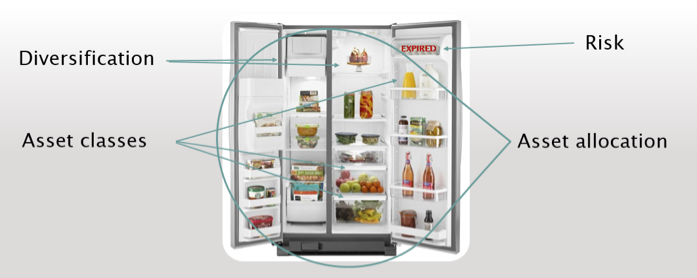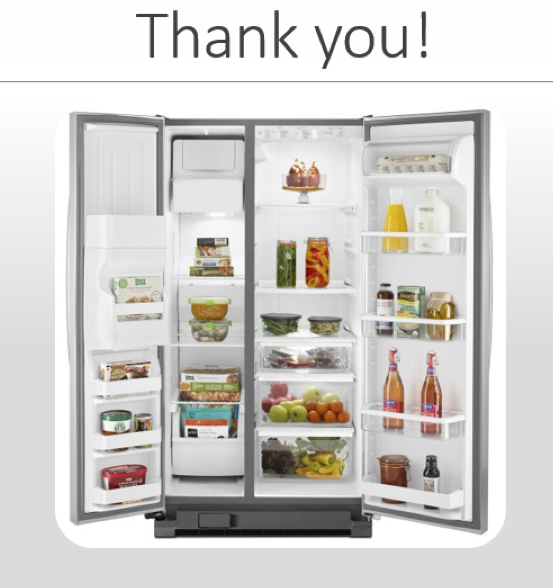I believe all practitioners have the same problem I’ve faced when attempting to educate prospective clients regarding the elements of portfolio design. In my years of teaching the graduate Wealth Management class at Texas Tech, I’ve had the privilege of reading many fine papers; however, Ms. Winkelman’s is undoubtedly the most creative. I believe you will agree and will find it a useful tool in educating clients on the subject of diversification. Enjoy.
Hello, and thank you for meeting with me today. First, I want to applaud you both for investing in your future and sharing your goals with me. My focus today is to go over with you some tips and review some details about your current portfolio you might want to review further.
My hope for this presentation is that you leave with more knowledge and feel comfortable to ask any questions now, or that may come up later. So, let’s get started.

Yes, those are refrigerators. Before you run away, let me explain.
Not to worry, I haven’t completely forgotten why your meeting with me. The reason for the refrigerators is to help explain some of the investment terms that we will be discussing today. So first, what do you notice that’s different about these refrigerators?
The refrigerator on the left seems plain and simple, but gets the job done. The one on the far right, looks as though it has some additional bells and whistles that might perform additional tasks you’d find beneficial. The group in the middle showcases the 3 different refrigerators that look as if they may range from simple to elaborate. Do you think there’s a cost difference between these if purchased brand new and from the same store? Probably so. The simple refrigerator costs less than the one with all of the bells and whistles, and you would expect that because you are getting more because of the additional options.
Why does this matter? Well, when you are looking at a portfolio, what I’d like you to do is think of it as a refrigerator and what you need in order to meet your goals. While the elaborate refrigerator may look appealing, you may not need the additional options; nor would you want to pay more for when it is not needed. Also, the simple one may not provide you enough space or options, so you could choose something that fits in the middle. None of these options are good or bad, we just need to make sure your option is the best fit for your needs.

Staying on the idea of the refrigerator, let’s now take a look at some more investment terms.
First let’s look at risk. What is risk? Something that you are not willing to lose or that you want to protect yourself against. For this, think of eating something from your refrigerator that’s close to expiring, expired or way past expiration date—say eggs. What are you willing to risk by eating a bad egg? Again, tying this back to your portfolio, risk is what you are comfortable with in regard to loss. You want to consider what would keep you up at night and how much loss in your portfolio would cause you stress. This is also called risk tolerance.

Here we see your current personal account and IRA account. The blue indicates your concentration in technology and the green color represents the other asset allocation your portfolio is invested.
The reason for grouping investments as different asset classes helps diversify your portfolio. When you diversify, you ultimately utilize more baskets between all of your investments. This helps manage the risk (possibility of loss) based on how each asset class reacts to the changes to the market.
*Click* Currently, this is what your portfolio looks like as example of this basket of eggs. You have a variety of investments in the technology asset class (kind of like the different varieties of eggs in the basket), however these investments will react the same way when the market changes. If the market drops and the technology drops with the market, your portfolio is exposed to that risk because of the large amount invested in technology. Again, this is neither good nor bad. If technology does well, you will do well; however, by having a significant amount of your investments in technology, if it does poorly, this could potentially expose you to more risk of loss than you thought you were taking.

Here I’ve combined all of your accounts into a single picture to help you visualize what asset classes make up your portfolio. Here we see that you have a majority of your investments in technology and the remainder is in other; i.e., bonds and other kinds of stock. Why is this important? Because based on your desire for a conservative portfolio, there may be risks you were unaware of. Even though you have numerous technology funds, as they are part of the same asset class and will react to the market changes in the same way. As I noted, although there’s nothing wrong with being heavily invested in a single asset class, we need to make sure you know the risk you’re taking.

Another consideration we need to address is tax efficiency. What is tax efficiency? This means you want to minimize your tax liability given the options you have available. Currently, you are invested in a couple of different municipal bond funds, which have great tax advantages! You also have your portfolio divided into a taxable account (meaning any growth from investments—gains—you receive are taxed) and you have your IRA, which is a tax-deferred account. This means you don’t pay taxes on the income and growth right now, but instead at a later time.
You want to make sure that these investments are placed in the correct account, either taxable or tax deferred, to provide you the best tax efficient option. So if you have fresh eggs that can be consumed now, where would you keep those eggs? In the freezer side or the refrigerated side? Most likely the refrigerator side since you want access to eat them at any time. This would be the most efficient way to manage the eggs for your maximum benefit.

Another thought to keep in mind about your portfolio is “overlap.” Overlap is a situation where you own different mutual funds that hold similar investments. By owning a number of funds you may think that you are diversified, only to find out when they all lose money at the same time that the different mutual funds have invested in the same stock.
Say that you and your spouse talked about grocery shopping and you came up with a list of what was needed. Neither of you told the other that you were going to the store. When you came home, your spouse had just made it back from the same store you shopped at. As you can see comparing both of your grocery carts, there are similar items in both carts. This means you have more of those items than you needed.
This also can happen if you have an overlap in your mutual funds. It’s important to look at what each fund is made up of and compare them to ensure that you aren’t paying extra transaction costs for the privilege of having far more exposure to the same markets then you plan on.

Similar to tax efficiency, it’s important to consider the costs of having a specific fund or type of investment.
Think of expenses for investment accounts in the same way as the cost of grocery shopping. If you saw the same carton of eggs that had the same kind of eggs in the carton, which one would you choose? The lesser priced carton. Why? Well if you can get the same thing for a lower price what is the point in spending the extra money?
The same logic applies to reviewing the expenses within each fund in your portfolio. This idea is to find the best value for what you need and not paying for the same item twice (overlap).
Philosophy And Process

It’s similar to choosing between non-organic eggs and organic eggs. You might want to know some of the details behind the organic eggs. Such as, what is the company’s definition of organic? Is this your definition of organic? How do they insure the quality of their organic eggs? Has this company been in business long enough to give you confidence that they are successful at providing organic eggs? How long do they need to be successful for you to be comfortable with choosing them? And, is their price for these premium eggs worth it for what you find valuable? Again, neither of these is good or bad; it is based on how it can apply to you.
It may seem extreme to compare organic eggs to a manager of an investment fund; however, the same simple principles can be applied. You need to know the manager’s philosophy. What does she see about the markets that will enable her to beat all of the other professionals she is competing with? How does she make her philosophy work in the real world? If the fund charges more than others, is it justified? How long has she been at the helm? If a manager has been doing this for some time and you find a credible philosophy and process, this may be a reason to consider the fund for your portfolio. If not, you may want look for a better fit for your investment.

Those were just a few of the observations that I made over reviewing your portfolio. Thank you for stopping by to see me today and allowing me to share my knowledge with you. I hope this information was helpful and that you can use this to determine whether or not I would be a good fit to serve you and your goals. Either way, you can use this information to ask questions and think about what works best for you.
Lauren Winkelman is a teaching assistant and graduate student at Texas Tech University.